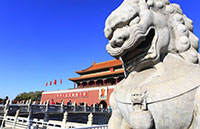Media mogul buys Song Dynasty letter for $31.7m
Updated: 2016-05-17 03:16
By Lin Qi(China Daily)
|
||||||||
 |
|
The letter, titled Jushi Tie, by Zeng Gong written in 1080. |
A Song Dynasty (960-1279) calligraphic letter of 124 characters was sold for 207 million yuan ($31.7 million) to Chinese media mogul and art collector Wang Zhongjun at a Beijing auction on Sunday night.
The letter, titled Jushi Tie (A Letter on Happenings), was composed by the famed politician and scholar Zeng Gong on Sept 27, 1080, during his 12-year service in local administrations.
In the letter, he thanks an unidentified friend for being supportive in the long term. Between the lines, however, he also shows a dissatisfaction at being unable to implement his political ideas in the royal court.
Zeng is ranked among the "eight masters of prose of the Tang (AD 618-907) and Song dynasties". Very few of his writings still exist.
Once owned by Belgian collectors Guy and Myriam Ullens, the letter was auctioned at 108.6 million yuan in Beijing in 2009.
The participation of Wang, who bid over the phone, surprised many people, since he is known for being an ardent buyer of contemporary Chinese and, recently, Western art. He spent $29.9 million on a Picasso painting, Woman With a Hairbun on a Sofa, at a Sotheby's sale in New York in May last year.
The letter by Zeng Gong topped the Grand View auction of classical Chinese paintings, staged by China Guardian Auctions, which grossed 1.11 billion yuan in total.
In the same sale, a calligraphic album in running script by the Ming calligrapher Song Ke was sold for 92 million yuan to Zhang Xiaojun of Shanxi province. An album of calligraphic Buddhist sutras, poems and paintings by intellectuals from the Tang and later dynasties sold for 57.5 million yuan.
The Grand View auction of classical Chinese ink art, held twice a year, is seen as a barometer of China's art market.
Luan Juli, general manager of China Guardian's Chinese painting department, said after the sale that classical Chinese art will play a bigger role in supporting the whole art market.
The most expensive classical Chinese ink art sold at auction is Di Zhu Ming, a calligraphic hand scroll by Song Dynasty master Huang Tingjian that fetched 436.8 million yuan in Beijing in 2010.
- Canadian PM to introduce transgender rights bill
- Hillary Clinton says her husband not to serve in her cabinet
- New York cake show designs fool your eyes
- ROK prosecutors seek 17-year prison term for attacker of US envoy
- World's biggest plane leaves Australia
- Conference calls for females to be put at forefront of development

 Apple's CEO Tim Cook's eight visits to China in four years
Apple's CEO Tim Cook's eight visits to China in four years
 Annual New York cake show designs fool your eyes
Annual New York cake show designs fool your eyes
 Divers find ancient Roman cargo from shipwreck in Israel
Divers find ancient Roman cargo from shipwreck in Israel
 Taoist priests worship their ancestors in Central China
Taoist priests worship their ancestors in Central China
 The world in photos: May 9-May 15
The world in photos: May 9-May 15
 Top 10 most generous companies in China
Top 10 most generous companies in China
 Wine market shrugs off slump
Wine market shrugs off slump
 Terracotta teddy bears debut in Wuxi
Terracotta teddy bears debut in Wuxi
Most Viewed
Editor's Picks

|

|

|

|

|

|
Today's Top News
Liang avoids jail in shooting death
China's finance minister addresses ratings downgrade
Duke alumni visit Chinese Embassy
Marriott unlikely to top Anbang offer for Starwood: Observers
Chinese biopharma debuts on Nasdaq
What ends Jeb Bush's White House hopes
Investigation for Nicolas's campaign
Will US-ASEAN meeting be good for region?
US Weekly

|

|








